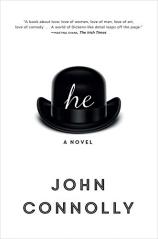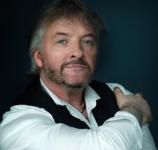He
Review
He
HE is a labor of love. It is a fictional biography of Stan Laurel, who, while still deeply revered by people of a certain age, is all but unknown to the last two or even three generations.
My maternal grandfather, a hardworking man of quiet generosity who was not given to mirth, found great joy in the comedic two-reel shorts and longer films featuring Laurel and his partner, Oliver Hardy, which were issued in the late 1920s and ’30s. When these showed up on television in the ’50s, we would laugh --- howl --- in unbidden unison at the same parts, at the same moments. I didn’t quite understand television as a child. When in 1957 I read a newspaper article stating that Hardy died, I cried my eyes out, thinking that their exploits would no longer be on TV. Thirty years later, I showed VHS tapes of Brats, The Music Box and many others to my sons, and we repeated the pattern established by my grandfather. They are still funny to me --- to us --- even after literally hundreds of viewings. However, this account of Laurel’s life is by far more tragic than mirthful.
"HE is a labor of love.... This is a work of fiction, based on facts, and Connolly projects, extrapolates and takes chances. There are surprises."
John Connolly’s HE makes demands. Laurel is referred to as “he” throughout and is the only person accorded that pronoun, as well as its derivatives and alternatives. Connolly uses full names each time another person is mentioned, thus interrupting the flow of his own narrative. It takes a while to get used to this. The book also jumps back and forth in time, between Laurel’s early years moving forward and the closing years of his life, when he sits in his rooms at the Oceana Apartments, dreading and brooding not so much his own death but that of his comedic partner. There is also, of course, the marked difference between HE and Connolly’s other work, primarily his superlative Charlie Parker series steeped in the mysterious and supernatural. Those who know Connolly through those books may not be inclined to follow him here. Conversely, others who are familiar with Laurel and Hardy may shy away from this treatment by a thriller writer. Yet the short chapters and subject matter make for compelling reading.
This is a work of fiction, based on facts, and Connolly projects, extrapolates and takes chances. There are surprises. Even though HE is mainly about Laurel, Connolly paints Hardy as a sympathetic character, which has not always been the case in other accounts of their partnership. The loyalty described between the two was amazing for that or indeed any era. They needed that to get through. Both men had a tragically canny ability to marry badly and repeatedly, and suffered from bad agreements with their movie studio that would haunt them for all of their days. Laurel is almost universally recognized as the directing and guiding light of their comedic genius, someone who labored long into the night after the cameras were shut off, writing lines and acting out movement, while Hardy engaged in various outside pursuits, such as golfing and wenching. It was Hardy, though, who Laurel credited as being one of the foremost actors of thator any time, and rightfully so.
Hardy simply made it look easy, whether he was fluttering his tie out of embarrassment, doing a pratfall, or breaking the fourth wall to give the audience a look of shared commiseration whenever Laurel’s on-screen character messed up. Connolly presents Hardy through Laurel’s eyes and somehow magically communicates in a few words how the whole was greater than the sum of its parts. He also shoots a subtle irony through the book. The vignettes describing the moment when Laurel and Hardy realize how popular they have become are some of the saddest in the novel. The message --- be careful what you wish for --- has never been starker.
Connolly wisely does not even attempt to describe the hundreds of moments that give rise to laughter in the Laurel and Hardy canon. How could he or anyone adequately do so? If you are familiar with the duo, you know what I am talking about, and should read Connolly’s treatment to get a balanced appreciation for what they did. If you have missed such wonders as Way Out West, Brats (in which they play themselves and their children) and The Music Box, please check those out (they are readily viewable on YouTube) before attempting HE. You will appreciate it more, both for what it does and what it doesn’t do.
Reviewed by Joe Hartlaub on May 11, 2018
He
- Publication Date: August 6, 2019
- Genres: Fiction, Historical Fiction
- Paperback: 464 pages
- Publisher: Quercus
- ISBN-10: 1635060583
- ISBN-13: 9781635060584




